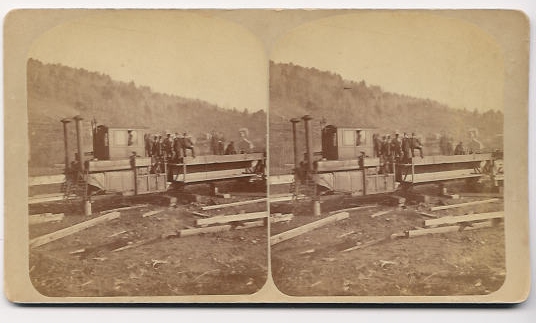Updated: 7 June 2012
Col Wilcox loco added
More info


The Bradford Monorail |
Updated: 7 June 2012
|  
|
 | Left: The Bradford & Foster Brook Monorail of 1878
This machine, with its twin chimneys, looks like it might have had some inspiration from The Lartigue Monorail, but actually it was a modified version of General LeRoy Stone's Centennial Monorail; the Lartigue came later. Like Stone's locomotive, the original Bradford locomotive appears to have had a rotary steam engine, but no details are known. However, it was clearly short of power, because later engines used the more effective piston drive.
Whether this is the original engine or the new one that exploded (see below) is uncertain.
|
This monorail was operated on a four-mile line between Bradford and Gilmore, Pennsylvania, USA; it was chartered in October 1877. It was intended to transport oil drilling equipment and its workforce, but before long was tranporting local passengers as well.
Eli Perkins, who travelled on the line in February 1878, wrote:
"The locomotive is a queer looking thing. An Irishman here compared it with a gigantic pair of boots swung over a clothes line. The boiler is without a flue, the engine without a piston, and the driver without a crank. I rode with General Stone around corners and up steep grades as thirty miles an hour."
The speed reported was widely disbelieved, and Perkins' account is also undermined by the fact that the railway had no corners, and little or nothing in the way of grades. However it is interesting to note that General Stone was taking an interest.
The Bradford-Gilmore line was the scene of the worst disaster in monorail history, on the 28th of January, 1879. A new and larger piston-driven engine was being demonstrated, pulling a flatcar full of officials. The train was being run at high speed to demonstrate its capabilities; the boiler exploded, apparently due to too low a water level, and the train crashed into a creek, killing George Grogan, (conductor) John Vaughn, (engineer) John Addis, (brakeman) Charles Shepherd, (assistant superintendent) Michael Hollivan, (fireman) Thomas Luby. (engineer) The three surviving passengers, Sterret, Peterson, and Gartside were seriously injured. The line closed shortly afterwards; in February 1879 it was sold to Allen & Skidmore, and in March 1880 it was disposed of at a 'sheriff's sale'. (This is a public auctions to satisfy legal judgments, usually conducted under the authority of the sheriff of the county or city in which the property to be auctioned was seized pursuant to the judgment)
This disaster is in contrast to the resilience of the Lartigue monorail, which proved highly resistant to deliberate sabotage in Ireland.
 | Left: This stereo photograph is believed to be the only other image of the Bradford & Foster Brook Monorail.
Skeletal cow-catchers can be seen at the front, on either side of the central beam.
|
 | Left: A later locomotive of the Bradford & Foster Brook Railroad: 1878
This 0-4-0 locomotive looks like a much more professional job than that illustrated above. It was built by Baldwin in 1878, with shop number 4370. It balances on a single rail, with outriggers holding small wheels that press against rails at the bottom of the picture, in order to keep upright. It differs from the Lartigue system in that the top rail is supported by a column rather than an A-frame, so the two lower rails are close together.
Col. A I Wilcox was the president of the company.
|
I suspected at first that this might have been the locomotive that exploded; certainly it is piston driven. However according to "History of the counties of McKean, Elk, and Forest, Pennsylvania" by J H Beers & Co, the accident happened during a trial of a new locomotive built by Gibbs and Sterrett; as noted above, Sterrett was one of the injured. This company had a complicated history but eventually became the Climax company that built geared logging locomotives.
Note the long cylindrical tank slung below the locomotive with "Bradford & Foster Brook Railway" written on it; this presumably held water. It is not clear from the photograph but no doubt there was another such tank on the other side.

  
|